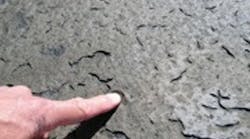What’s simple, durable, expensive, and welcomed by a wide swath of the roofing industry?
If this item existed, we probably would have favored it for decades. But who would have been conscious of ozone depletion, sources of smog, global warming, urban climate change, LEED, OSHA, asbestosis, mesothelioma, toxicity of arsenic, lead, and chromium, recycling, emissivity, and albedo a few decades ago?
Actually, that material does exist – and it’s still in use today. For low slope bituminous roofing systems, what goes around really does come around.
Bituminous Roofing Hits the Market
Back in the pre-World War II years, there were two bituminous substances (bitumens) that dominated the roofing industry. Coal tar pitch was a by-product of processing coal to make coke, which in turn was used in making carbon steel and electrodes for the aluminum industry. Asphalt, a by-product of processing petroleum to make gasoline, fuel oil, and various hydrocarbon polymers, was also popular.
Roofing systems originally consisted of alternate layers of hot bitumen and reinforcement. The original reinforcement was called “organic felt,” a paper-like product consisting of waste paper, cotton linters, and asplund wood fibers.
Was the system simple, durable, inexpensive and welcomed by all? Actually, it was and still is. Since bitumens are vulnerable to ultra-violet imbrittlement, these membranes were surfaced with a flood coat of bitumen into which gravel or slag was embedded. This screened UV light and greatly improved fire resistance.
By the 1950s, a coated base felt was introduced, replacing the “two dry, three mopped” roof systems over wood decks. Where the flood coat and gravel surface was inconvenient, substitution of asbestos or fiber glass reinforcements permitted the omission of gravel, with asphalt-aluminum roof coatings or clay-stabilized asphalt emulsions used for UV protection.
Cut-back coatings such as solvent-asphalt-fiber systems were incorporated. Water-based white coatings such as White-Gard and Star-White were offered as a substitute for the aluminum coatings, but these were stained by migration of the bitumen into the coating and were not elastic enough to accommodate movement of the bitumen sub-surface.
In 1973-1974, we were faced with an oil embargo. Two-ply coated asphalt felts were introduced since there were less moppings of bitumen to be applied and less labor to install. Unfortunately, these two-ply roofs were troubled by blistering between the two coated sheets and lacked the proven durability of their 4- and 5-ply predecessors.
Meanwhile, some light-weight roof systems were having success in mild climate regions such as much of the West Coast and Arizona. They might be 2- or 3-ply systems with a mineral-surfaced cap sheet. At low slopes, inorganic roofing felts such as asbestos or glass fiber were used, since the organic-based materials would absorb water at side and end-laps if the roof ponded water.
Asphalt Emulsions Step into the Spotlight
We mentioned clay-stabilized asphalt emulsions earlier in this column. While asphalt is hydrophobic, it can be dispersed in water as long as an emulsifying agent is used, such as extremely fine particles of bentonite clay. This system provides a stable base for reflective roof coatings, and the cured coating has excellent fire resistance without needing gravel surfacing. The emulsions were so good that some roof systems marketed used a one-ply base sheet, followed by a generous application of emulsion and chopped glass fibers roving as reinforcing. The emulsions also proved useful when re-surfacing existing bituminous roofs and served as a base for reflective roof coatings.
Emulsion systems must be protected against freezing during storage, something that is true of acrylic systems as well. Many new roof systems, such as self-adhering modified bituminous membranes, aluminum roof coatings, and water-based insulation adhesives also require ambient and substrate temperatures during application of 50 degrees F. or higher.
Emulsion systems also contain no flammable solvents (no red label), they are permeable to water vapor, but not liquid water, which is very useful in damp-proofing and resurfacing. They contain few or no VOCs that contribute to the formation of smog. Also notable is that these systems are quick to apply. Because these emulsions do not flow when subjected to high temperatures, they make a stable base for the current generation of reflective acrylic roof coatings.
You might agree they are simple, durable, inexpensive, and welcomed by all!
Additional Roofing Resources
The Top 10 Most Common Roof Problems
Discover and understand issues plaguing low-slope roofs everywhere.
EPDM, Sustainability, and the Environment
Why EPDM has advantages over other elastomers.
Installing Membrane Roofing Using Foam Adhesives
The pros and cons of low-rise foams.
Richard (Dick) L. Fricklas was technical director emeritus of the Roofing Industry Educational Institute prior to his retirement. He is co-author of The Manual of Low Slope Roofing Systems and continues to participate in seminars for the University of Wisconsin and RCI Inc., the Institute of Roofing, Waterproofing, and Building Envelope Professionals. His honors include the William C. Cullen Award and Walter C. Voss Award from ASTM, the J. A. Piper Award from NRCA, the William C. Correll award from RCI, and the James Q. McCawley Award from the MRCA. Dick holds honorary memberships in both ASTM and RCI Inc.


